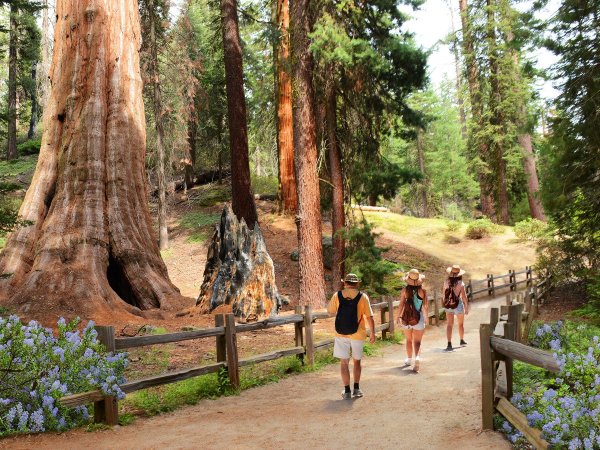Conrad Wirth, the U.S. National Park Service Director from 1951 to 1964, was the first to express concerns regarding parks being “loved to death” by recreationists. At the time, rising visitation rates and a lack of appropriate infrastructure were contributing to environmental degradation across some of the United States’ most iconic landscapes. Wirth’s concerns remain relevant as visitation numbers continue to rise for many outdoor recreation areas. In 2016, during the centennial year of the National Park Service, National Public Radio ran a story on tourism and overdevelopment in Yellowstone National Park, directly quoting Wirth in the article's headline. This was followed by similar stories of concern published in The New York Times and The Guardian.
More recently, the COVID-19 pandemic has introduced many new recreationists to the outdoors. On one hand, this growing use of parks is positive news regarding human health and wellbeing. The mental and physical health benefits of outdoor recreation have been well-documented, and increased use continues to support these benefits for more and more people. Amidst these increases in use though, what is to be said for the natural world that is integral to the character of these parks? Are we doomed to love parks and protected areas to death if outdoor recreation rates continue to increase? Maybe this choice between human health and ecological health does not have to become an “either-or” scenario.
Humans have been and will continue to be integral actors within park ecosystems. This was true prior to indigenous dispossession of these lands, is true today with the active management of public lands (e.g., invasive species removal, wildfire management, etc.), and will likely continue to be true moving forward. In short, humans belong in parks and in nature despite being the most difficult wildlife to manage. The dual mandate of providing for both human health and ecological health becomes a fine line to walk for outdoor recreation managers in the United States. Finding ways for outdoor recreation to promote environmental stewardship within participants presents a potential opportunity to maximize both outcomes. Perhaps we will not have to worry about loving outdoor spaces to death if we can more effectively promote a pro-environmental mindset amongst those visiting these areas.
Our research, conducted through the Department of Recreation, Park, and Tourism Management and in collaboration with the Leave No Trace Center for Outdoor Ethics, presents a potential pathway to understanding how outdoor recreation may support both human and environmental well-being. We examined how involvement with and knowledge about environmentally responsible outdoor recreation patterns influenced other pro-environmental behaviors that were unrelated to outdoor recreation (e.g., buying organic vegetables, donating money to protect the natural environment, etc.). Previously, an individual’s identity has been considered an effective predictor of general pro-environmental behavior. If someone sees themselves as a pro-environmental individual, they likely align a constellation of behaviors to be consistent with this self-perception to reduce cognitive dissonance. In our work, we built upon this framework and added outdoor recreation into the mix. We found that knowledge and practice of environmentally-responsible outdoor recreation were uniquely related to a range of pro-environmental behaviors as well. While causality cannot be established between these factors, this correlation suggests that educating outdoor recreationists on minimal-impact practices may have wide-ranging benefits regarding behavior towards the natural world.

In translating these findings to practice, the importance of education becomes increasingly apparent. Often, in park settings, visitors are taught a variety of prescriptive behaviors to guide their actions. These are mostly harm-avoidant behaviors, like staying on maintained trails to avoid trampling vegetation, keeping appropriate distances from wildlife to avoid habituation, and properly disposing of waste to maintain ecosystem health. If we can teach these behaviors in a way that engages a variety of social and psychological mechanisms, these prescriptive, harm-avoidant behaviors may translate into proactive stewardship of natural resources beyond the park or outdoor recreation setting. Teaching individuals to stay on a trail may go beyond promoting this singular action, reinforcing their likelihood of joining a local environmental group. Encouraging individuals to dispose of waste properly may encourage them to sign a petition about an environmental issue. This “spill-over” across behaviors may be supported through a variety of mechanisms including identity reinforcement, general knowledge development, community building, and developing connectedness to nature. This potential for behavioral “spill-over” is promising during a time where our human and environmental well-being certainly need help.
As we look to the future of parks, protected areas, and outdoor recreation in the United States, it can be easy to get lost in the tension between access and overuse. But this may be overemphasized, at least if we can develop wide-reaching and diversified educational practices. If we can educate individuals regarding responsible outdoor recreation practices in parks and protected areas, we have the opportunity to promote “spill-over” behaviors that can address other wide-reaching environmental issues. “Loving parks to death” sounds like a catchy phrase, but strong educational practices may be one of the tools we need to direct this love towards much more positive means.






